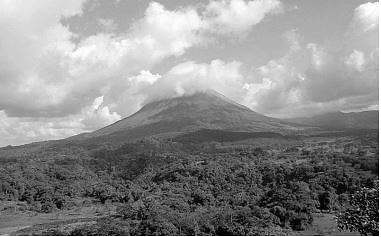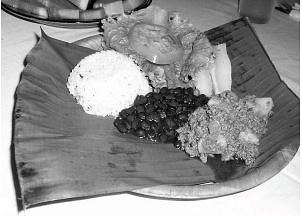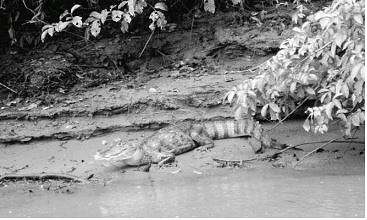ARENAL VOLCANO
AND CAÑO NEGRO
Leaving the Sarapiquí region, we circled toward the Norte Lowlands to La Fortuna, a town nestled in view of Arenal Volcano. Costa Rica sits on a tectonic plate with 292 volcanoes, seven of which are active; of these, Arenal is the most active. Driving by grazing beef cattle, papaya, and skinny yucca plants, we climbed to the village of San Miguel at 900 feet above sea level. It was Sunday; families were on their way to church. 60% of Costa Ricans are Catholic; every village has a church, a school, a local bar, and a Chinese restaurant, explained Pablo, whose grandfather was also Chinese. We could see Nicaragua behind the flat fields.
Arenal Volcano with its crater top appeared 40 kilometers before we reached La Fortuna. A road stop introduced us to orange iguanas, indicating it was the mating season, when males change color. Families of iguanas with their long tails, which they whip for protection, languished on tree branches. People with machetes harvested sugar cane in the fields. La Fortuna welcomed us with a big sign for bungee jumping. Because of the city’s proximity to the volcano, its main industry is tourism; souvenir shops surround the central park, facing the Catholic Church.

Arenal Volcano
The Casa Luna Lodge, our home for the next two nights, was away from the commercial zone, with spectacular views of the volcano. I felt fortunate to have a second-floor room with a balcony, where I could view the cone-shaped volcano as its mist-shrouded look changed during the day. Of its four craters, only two are active. When pressure builds up inside the mountain, lava erupts, hardening into a ball upon contact with the air and then rolling down. Having awoken from a long dormancy in 1968, the volcano has since been constantly active. Its lava is visible at a distance after dark on clear days.
Our morning activity was a trip to Chachagua, a town of humble homes with satellite dishes. Here we visited Rosie, who taught us how to make empanadas. Round balls of dough are pressed out by hand into circular shapes and spread with cooked mashed beans and cheese. Then they are folded into a half-moon shape and sealed by pressing the edges with the tines of a fork. After we had initialed our empanadas, Rosie deep-fried them in safflower oil. Accompanied by our choice of filtered coffee or sweet water, made by boiling sugar cane in water flavored by star fruit, we enjoyed the empanadas with salsa lizano, a popular Costa Rican hot sauce.
A visit to the San Francisco Elementary School in La Fortuna was delightful. Each of us was met and befriended by a child as we descended our minivan. My companion was Steffannie Marín, a fourth-grader. After hearing the national anthems of our countries and watching young folkloric dancers, we toured the school. Holding my hand, Steffannie led me to the computer lab, after which we visited the chicken coop and grain fields, all part of her education. Then she invited me to work on a complex jigsaw puzzle of jungle animals. Mostly with her help, we finished the puzzle. Education is mandatory and free in Costa Rica, and is considered the second national priority after health. The government pays for transportation and uniforms. School subjects include behavior and physical education, which are tested every three months.
Splitting into groups, we had a home-hosted lunch with the students’ families. My group visited a farming family with four children, two of whom were at home. The father, who knew some English, explained that his crops were mainly plantains and cassava; he supplied the wholesale market. Our meal consisted of palmito (palm heart) salad, fried plantains, and beef with rice and beans, served with tortillas and rice pudding.
During a two-hour nature hike, we crossed fifteen hanging bridges as we passed through the Arenal rain forest. Leaf-cutter ants moved about busily on the forest floor, howler monkeys enjoyed the tree tops, and waterfalls gushed down the mountainside. As the sun went down, we drove to a lava lookout. Seeing one flash from the van, we hurried out, eager for more. Unfortunately, all we saw during our one-hour wait was two tiny balls at a distance. This was not our lucky day.
The next overland adventure was to Caño Negro Wildlife Refuge near the Nicaraguan border in the north. On the way to visit a village inhabited by the Maleku, one of eight indigenous communities left from Costa Rica’s original twelve, we drove through heavy rain on a bumpy road filled with potholes and puddles, and crossed rickety bridges over streams. We arrived in a village of brightly colored small houses — ochre with purple trim, green with pink columns, and pink with matching tulle curtains. Laundry seemed to be hanging everywhere. In this poor but cheerful community lived a proud people, trying to preserve their culture against the influence of churches. A Methodist church was visible at the village entrance.
Iqui, our Maleku hostess, spoke of her people’s beliefs and way of life. The Maleku generally do not marry outsiders; in the rare event of such a marriage, the new spouse must be accepted as a member of the community. The Maleku believe in nature and communicate with their god individually, by a river or a mountain. The dead are buried in their homes, stacked up in the kitchen, as there is limited land. Maleku women who are divorced or widowed may not marry again. The colors on crafts, such as gourds and masks, are inspired by vegetation. The Maleku use iguana skin for drums and eat iguana meat, which tastes somewhat like chicken.

Casado plate
After viewing crafts, we enjoyed lunch in the communal space. Lunch was typical meat casado with yucca, served on a banana leaf. Water was potable, even in this remote area. While the government has not yet invested in back roads, it provides electricity and pipes water from filtering stations to every community. Walking through the village with Iqui, I saw a sign saying “Here we strive to be better.” A soccer field stood idle due to recent rain. We stopped by the radio station and met the Maleku DJ. Working solo, he broadcast daily from 4 am to 6 pm. With deep appreciation for these hard-working, beautiful people, we continued on our way.
In this part of Costa Rica there is a rainy season and a less rainy season. However, heavy rains, descending fog, and bumpy roads are no reason to stay away. There is always a reward at the end. One such treat is the Caño Negro Wildlife Refuge, one of the major wetlands in the world. Founded in 1984, it is home to 315 species of bird and some 2000 species of butterfly.
Upon checking in at our lodge, we learned about the Certificate of Sustainable Tourism (CST) program, which is followed throughout Costa Rica. Criteria for recognition include low energy consumption, solar panels, scheduled use of water, recycling, homemade compost, aid to local small businesses, and cooperation with the community. In this spirit, we met local women who make and sell jewelry from beads combined with jungle seeds. We were all happy to be supporting the local economy.

Caiman sunning itself on bank
At 6 am we left for a boat ride through the inland canals in search of wildlife. We glided between shores lined with palms and jungle growth stretching out over the water for sunlight. Families of caiman sunned themselves on the banks, blending in with logs. A flock of vultures took off from a tree; snowy egrets, still as statues, perched on branches. A tiger heron with striped feathers and a green kingfisher looked for food as our boat maneuvered in intermittent rain. A haven of biodiversity, the jungle and waterways are home to cormorants, tanagers, northern jacana, jabirus, wood storks, whistling ducks, iguanas, and many other species.
Later we visited the Turtle Conservation Center. Started in 1991, this project has been able to mark 48,000 turtles by cutting a notch into each of their shells. Seven families collect the eggs in swamps, and incubate them after cleaning and measuring them. By controlling the temperature of the nesting area, these people are able to determine the sex of the turtles: 33-35º C for females, and cooler temperatures for males. Each female hatches 6 to 38 eggs; 18,000 freshwater green turtles are produced per season. After three months 30% of the turtles are released into the wild, another 30% are split between the families and the Center, and the rest are sold to aquariums. 80% of the eggs in the center hatch, with a survival rate of 5%, as opposed to 40% which hatch in the wild, with a survival rate of 1-4%. Ants, birds, raccoons, jaguars, and humans seek the eggs for food. Female turtles stay fertile for up to 70 years and have a life span of 140 years. A turtle’s gender can be identified at seven months — males are small; females have a flat belly and claws.
Our nature study continued with a visit to a butterfly farm. Costa Rica has more butterflies than the US and Europe combined. Each species has a host plant and lays eggs on the underside of its leaves for protection from rain. After hatching, a caterpillar grows to 10,000 times its original size by constantly eating, and then changes into a chrysalis. Monarchs fly between Canada and Costa Rica to avoid seasonal poisonous secretions of their host plants. We walked around a netted area filled with flowering plants and livened by butterflies of all sizes and colors.
We ended our day at the lodge bar making tapas — thinly sliced and deep-fried yucca chips, thick slices of plantains pressed and fried as canapés for refried beans and guacamole, plus a delicious relish of onions, tomatoes, cilantro, lime juice, soda water, and pepper sauce. We helped slice and chop the vegetables, and enjoyed the tapas with a drink afterwards.
Planting a tree to help revitalize the ecosystem was our parting activity in Caño Negro.
← Costa Rica (main page)
